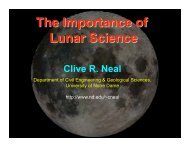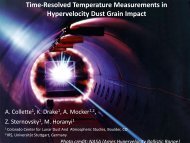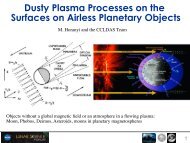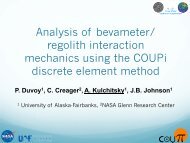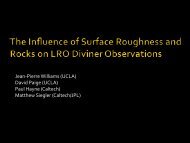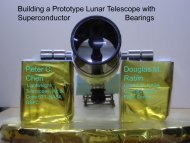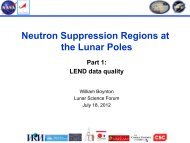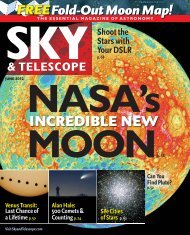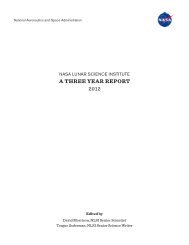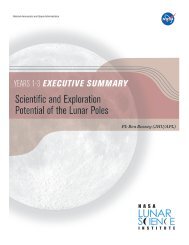- Page 1 and 2: NASA Conference Publication 3343Fro
- Page 3 and 4: PREFACEOn June 24 through 26, 1996,
- Page 5 and 6: TABLE OF CONTENTSPreface...........
- Page 7 and 8: The role of hydrogen in small amorp
- Page 9: P PIC AND SIMILAR DISK-LIKE OBJECTS
- Page 12 and 13: y linear deconvolution of the SSA i
- Page 14 and 15: `planetesimals'. Those ones are spa
- Page 16 and 17: o Variations of the size of the blo
- Page 18 and 19: Table 1 Best-fitting model paramete
- Page 20 and 21: 10-10SAO 179815 (HD 98800)10-1110-1
- Page 22 and 23: 2. 0 Pic-like SYSTEMSOne of the gre
- Page 24 and 25: Backman, D. E., and Paresce, F. 199
- Page 27 and 28: PARTIALLY CRYSTALLINE SILICATE DUST
- Page 29 and 30: 12D 100546 vs Forsterite (dashed) a
- Page 31 and 32: HIGH RESOLUTION SPECTROSCOPY OF VEG
- Page 33 and 34: accretion hypothesis, King (1994) i
- Page 35 and 36: TRANSIENT ACCRETION EVENTS IN HERBI
- Page 37 and 38: e ionized by the stellar radiation
- Page 39: STAR FORMATION31
- Page 43 and 44: iEiifr.O-10 V351 OriR = 3.10E(B—V
- Page 45 and 46: DUST AROUND HERBIG AE STARS:ADDITIO
- Page 47 and 48: Table 1 Observational characteristi
- Page 49 and 50: AN INFRARED STUDY OF THE JUGGLER NE
- Page 51 and 52: Figure 1. M2.2 - M3.45 with ri,,: A
- Page 53 and 54: quarter-wavelength farther than the
- Page 55 and 56: parallel to the magnetic field dire
- Page 57 and 58: THE SPECTRAL ENERGY DISTRIBUTION OF
- Page 59 and 60: 0a+ (Azm): 3 (lin), 1 (dot), 0.3 (d
- Page 61: _.. .._ .... ......... ............
- Page 64 and 65: 2. EXTERNALLY INDUCED EVAPORATIONEx
- Page 66 and 67: 16Radial Size of Externally Photoev
- Page 69 and 70: THE 11 pm SILICON CARBIDE FEATURE I
- Page 71 and 72: 1.1f,.9^^^^^^^m ^^mmm a1aam MFG= IR
- Page 73 and 74: ON THE CLASSIFICATION OF INFRARED S
- Page 75 and 76: mvUALLIIuaLi8 10 12 8 10 12 14'N UL
- Page 77 and 78: FORMATION OF COSMIC CARBON DUST ANA
- Page 79 and 80: actual hydrogen abundance in the am
- Page 81 and 82: TIME DEPENDENT MODELS OF GRAIN FORM
- Page 83 and 84: 3. NUMERICAL METHODIn solving numer
- Page 85 and 86: THE SIZE DISTRIBUTION OF STARDUST I
- Page 87 and 88: 25—5 (b)2015Ea 1050LV.Odr.3vgc0
- Page 89 and 90: CONSTRAINTS ON CIRCUMSTELLAR DUST G
- Page 91 and 92:
2. DUST AROUND A COOL STAR: a SCOAn
- Page 93:
INTERSTELLAR DUST85
- Page 96 and 97:
stellar groups represented in Table
- Page 98 and 99:
-1-Table 2. Requirements of selecte
- Page 101 and 102:
THE INTERSTELLAR POLARIZATION FEATU
- Page 103 and 104:
T-,rTf HD 1977700°mm0 00a 2mmmm00
- Page 105 and 106:
INTERSTELLAR EXTINCTION, POLARIZATI
- Page 107:
4j—^--^ HD594213.532.52F --- I HD
- Page 110 and 111:
The current state of knowledge is b
- Page 112 and 113:
Acknowledgements.MGR is funded by a
- Page 114 and 115:
2) Absolute photoluminescence (PL)
- Page 116 and 117:
4. CONCLUSIONSOur primary conclusio
- Page 118 and 119:
ACH2 615-CACH2cdWUC 15°C0.50,n 6AC
- Page 120 and 121:
Although contributions of C-H bonds
- Page 122 and 123:
Boulanger and Puget (1988, hereafte
- Page 124 and 125:
432100.10U) 0.080 0.06CO 0.0404 0.0
- Page 126 and 127:
2. IMAGE PROCESSINGThe 25° x 25°
- Page 128 and 129:
Raw 25 umAl"61088zaFI lyWz oa4^ FN3
- Page 130 and 131:
-05°26'30"40"/0,^3.29 µm50"0toMCc
- Page 132 and 133:
arises from H-PAHs. Within the two-
- Page 134 and 135:
Zwet and Allamandola 1985; Leger et
- Page 136 and 137:
Table 1. Rate constants of the reac
- Page 138 and 139:
Ehrenfreund, P., and Foing, B. H. 1
- Page 140 and 141:
0-.2CLai® .5UOCL 1L (a) W33A .61.5
- Page 142 and 143:
more quiescent material in lines of
- Page 144 and 145:
3—A -- B2.5 , ; ---CryVx 20.51.51
- Page 146 and 147:
1 1--0.--- 0.2------0.50 aCr0.50.50
- Page 148 and 149:
the NGC 2024 cloud were identified
- Page 150 and 151:
6. 13 IN THE CS CONDENSATIONS AND F
- Page 152 and 153:
quantities depend on the column den
- Page 154 and 155:
-6—8—10—12e7 a+ HCO+oB6g+Gg 9
- Page 156 and 157:
148
- Page 158 and 159:
^ O ) H H0Adsorption C OH Hmetal su
- Page 160 and 161:
P (in bars) at 550 K54- 0 T =450K-
- Page 162 and 163:
is worthwhile to study: N 2 + 3 H 2
- Page 164 and 165:
INITIRL 5 q 1000se e • •• s
- Page 166 and 167:
aggregates. Internal restructuring
- Page 168 and 169:
Ito+20o$1e+20CLASS IIICLASS omE to+
- Page 170 and 171:
Radef d^ d agnpfts gemated by Memal
- Page 172 and 173:
feature for this process is a relat
- Page 174 and 175:
tree-method, which is insensitive t
- Page 176 and 177:
structure were performed by Ossenko
- Page 178 and 179:
5E 0 —5—100'J —150 015E 100O5
- Page 180 and 181:
and Fessler, 1994. Dobrovolskis et
- Page 182 and 183:
1. Particles can not only be concen
- Page 184 and 185:
10.05.02.0rr e'rrseo®v ^s ^SC 1.00
- Page 186 and 187:
We have reproduced these results by
- Page 188 and 189:
orbitalmotiono^bs.a 0a.I~-1.Sun—4
- Page 190 and 191:
4. DISCUSSIONS AND CONCLUSIONSOur t
- Page 192 and 193:
The z-component of the vorticity eq
- Page 194 and 195:
(a) (b)60 6040 40Y 0 Y20 2020 40 60
- Page 196 and 197:
spreading out. It is during this st
- Page 198 and 199:
our solar system, where the mass of
- Page 200 and 201:
and the disk mass accretion rate MD
- Page 202 and 203:
of the CAIs, which is consistent wi
- Page 204 and 205:
particle motion and growth in such
- Page 206 and 207:
100.5a 0NE Ua 1c.0.110-0.5r`19.59-1
- Page 208 and 209:
200
- Page 210 and 211:
planets as primordial, since the la
- Page 212 and 213:
planets to set bounds on the masses
- Page 214 and 215:
o ^/ Fragment Chain(magnification 1
- Page 216 and 217:
24P = 6 h21w18Exr 15012c.C 97 OUCW1
- Page 218 and 219:
acting on a DP is the sum of the in
- Page 220 and 221:
Figure 1. The evolution of a dust p
- Page 222 and 223:
SUNY9xV105Y1 VEGA-2XvFGA— rGIOT7Q
- Page 224 and 225:
-1.0-0.sYS nr0+0.s+1.010 -4 10-3 10
- Page 226 and 227:
observers information on the condit
- Page 228 and 229:
220
- Page 230 and 231:
ding a biased sample of asteroids,
- Page 232 and 233:
Figure 1. Porosities of Chondritic
- Page 234 and 235:
Brownlee, D. 1994 1 in Analysis of
- Page 236 and 237:
a a^(a)dark and granular QCC(b)dark
- Page 238 and 239:
in the highest wavenumber region am
- Page 240 and 241:
Pfalzner, S. 163Price, S.D. 65Rank,
- Page 242 and 243:
elemental abundances 89ERE 105(Exte
- Page 244 and 245:
236
- Page 246 and 247:
238
- Page 248 and 249:
240
- Page 250 and 251:
Thomas G. BarnesDavid BlakeMcDonald
- Page 252 and 253:
Geoff BriggsNASA Ames Research Cent
- Page 254 and 255:
Jeff CuzziCarsten DominikNASA Ames
- Page 256 and 257:
Sheila FaracoTom GeballeAv.Celso Ga
- Page 258 and 259:
Reggie L. HudsonElmarJessbergerDepa
- Page 260 and 261:
Monika KressNASA Ames Research Cent
- Page 262 and 263:
1. Mann John MathisMPI fur Aeronomi
- Page 264 and 265:
Ryosuke NakamuraTobias OwenDept. of
- Page 266 and 267:
Gibson ReavesThomas RoelligDepartme
- Page 268 and 269:
Michael SitkoTomasz StepinskiUniver
- Page 270 and 271:
Robert G. TullGary WalkerMcDonald O
- Page 272 and 273:
Adolf WittDr. Chillier XavierRitter



